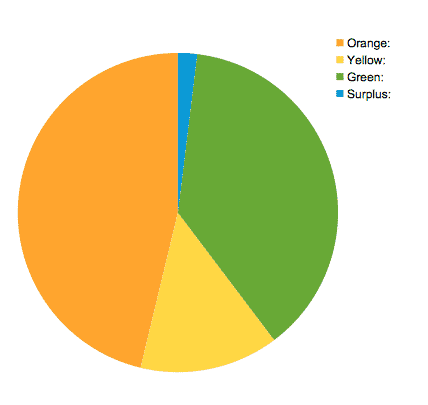1. Know Your numbers
Financial Analysis- Track your spending for 3 weeks.
- Don’t change anything.
- Be honest about every cent.
2. Keep A
Spending
Diary
- Do you have triggers – lunches, clothes, video games, drinks?
- Do you spend more or less on some things than you thought?
- How many Direct Debits and Subscriptions do you have?
- Use apps like fudget or just a spread sheet or a notebook.
- Use online banking to look at the previous months. Make sure you account for all purchases.
3. Colour Code budget
- Not all spending is equal. Here’s how to use Financial Planning to split your spending into three groups:
ORANGE
- Fixed
- Regular
- Non-Negotiable
- Rent
- Mortgage
- Debts
- Loans
Yellow
- Less Fixed
- Regular
- Needs planning to change
- Utilities
- Phones
- Subscriptions
- Contracts
Green
- Flexible
- Frequent / Regular
- Needs little effort to change
- Groceries
- Recreation
- Grooming & Clothes
4. Income & Expenditure
Fiach & Angela: Case Study- Fiach & Angela, 26, have a combined income of €4,500 per month.
- Their rent is €1,550 per month.
- They have a car loan of €300 per month.
- They spend €100 per month on their phones.
- Their utilities, like broadband & electricity, cost €300 per month.
- They have a life insurance policy that costs €51 per month.
- Their groceries cost roughly €700 per month.
- They spend roughly €712 on clothes, recreation, etc.
- Between public transport & taxis, they spend €100 per month.

- 46.3% on Orange, fixed expenditure;
- 14% on Yellow, monthly expenditure;
- 37.8% on Green, flexible expenditure;
- 1.9% is left as the Surplus.
5. Switching & Saving
Act Daily, So You Can Plan YearlyLook at your Spending Diary:
- How many Direct Debits do you have, and what do they do?
- Check your contracts and subscriptions. Do you need them all?
- Mark when the contract is up in your calendar
- Compare providers for the best deal
- Change when your contract is up
- Check how long until your contract runs out
- Check the cancellation fee
- If the fee costs less than your bill until the end of your contract, can you afford to cancel now, rather than later?
6. Spread Big Yearly Payments
Example: Car Costs
Caoimhe runs a car she owns outright, so she doesn’t have to worry about a loan each month. Unfortunately, between August & September, Caoimhe receives bills for:| Motor Tax: | €390 |
| Car Insurance: | €1,500 |
| NCT: | €55 |
| Servicing & Repair: | €800 |
| Total: | €2,778 |
- She can start saving now for her car costs
- Saving €232 p/m for a year will cover all her costs, based on last year.
- If €232 is too much, €150 p/m is more affordable for Caoimhe.
- This will cover her tax & insurance.
- If Caoimhe can pay her tax & insurance in one payment, she can avoid paying interest on monthly payments
- This interest can be as high as 20%, so Caoimhe could be saving €378 per year.
7. Setting Your Targets
Achieving Your Goals:
- Don’t just tell yourself to spend less.
- Decide to save this amount, by doing that: If you bought a pack of crisps each day at lunch, for .85¢, 5 days a week, you could save €204 per year by cutting it out.
- Set yourself Short-Term, Middle-Term & Long-Term goals.
- Short-Term goals can be as simple as cutting out a bad habit, and saving that money.
- Middle-Term goals can be switching your contracts for a better deal.
- Your Long-Term goals can be anything from a savings goal, clearing your debt, or building the deposit on your home.
- Short and Middle-Term goals are the small steps that will help you get there.
8. More Ideas
Let’s get started!Challenge Yourself:
- Look at your bank statements from this month last year. Can you spend less, and beat that month?
- Try a day per week where you spend nothing.
- The week after a bank holiday is the perfect time to try meal planning. Your weekend is longer, and your week is shorter.
- Like car costs, plan some spending yearly & keep a separate account for this fund.
- Give yourself a fixed amount each year to spend on clothes or grooming. Do you have options to repair, rather than replace?
- Planning ahead can allow you to purchase better quality replacements, which will last longer.


